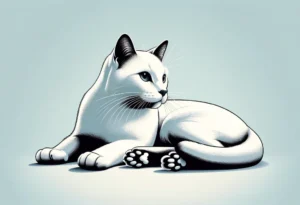Australian cats have short tails for a reason – but have you ever wondered why? Let’s explore the fascinating explanation behind this unique trait of our feline friends.
Have you ever noticed that Australian cats often sport shorter tails than their counterparts around the world? This distinctive feature is not just a random occurrence – it actually serves a specific purpose that is deeply rooted in the environment and history of these felines.
Evolutionary Adaptation to the Australian Climate
Australian cats have developed short tails as an evolutionary adaptation to the harsh climate and unique ecosystems of the continent. The Australian outback poses various challenges for wildlife, including extreme temperatures, scarce water sources, and predators. This harsh environment has influenced the evolution of Australian cats, leading to the development of shorter tails to increase their chances of survival.
The shorter tails of Australian cats help them navigate through dense vegetation and rocky terrains more effectively. These agile felines can maneuver swiftly to catch prey or escape from predators. In addition, the reduced tail length minimizes heat loss, helping them regulate their body temperature in the scorching Australian heat. This adaptation allows Australian cats to thrive in their challenging environment and increase their chances of survival.
For a deeper dive into the evolution of Australian cats and how they have adapted to their environment, check out this informative resource on wildlife adaptations in Australia: Wildlife Adaptations in Australia.
Predation and Survival Tactics
Having a shorter tail provides Australian cats with a competitive advantage in terms of agility, speed, and evading predators in the wild. In the Australian outback, where survival of the fittest is the law of the land, these felines rely on their quick reflexes and nimble movements to outsmart their prey and avoid becoming a meal themselves.
The short tail of Australian cats allows them to make sharp turns and sudden movements with ease, essential for hunting small prey like insects or rodents. Their enhanced maneuverability also helps them escape from larger predators such as snakes or birds of prey. By adapting to have shorter tails over time, Australian cats have honed their survival tactics to thrive in a challenging and competitive ecosystem.
In conclusion, the short tails of Australian cats are not just a physical trait but a valuable adaptation that has helped them survive and thrive in the diverse and unforgiving landscapes of Australia. Whether navigating through dense vegetation or outsmarting predators, these felines have evolved to be true masters of their environment.
Cultural Significance of Cat Tails in Australia
Did you know that in Australian folklore and indigenous traditions, cat tails hold significant symbolism? Cats are often seen as mystical beings, and their tails are thought to represent agility, grace, and independence. In some Aboriginal stories, cats with short tails are believed to be protectors of the home and bringers of good luck. This cultural significance has influenced the breeding of Australian cats, leading to the prevalence of short-tailed felines in the country.
Crossbreeding and Genetic Influences
When it comes to the short tails of Australian cats, crossbreeding and genetic influences play a crucial role. Through selective breeding practices, a genetic mutation that causes shorter tails has been perpetuated over generations. This intentional breeding has resulted in Australian cats having naturally shorter tails compared to their counterparts in other regions. The unique genetic makeup of Australian cat breeds contributes to their distinct appearance and sets them apart from cats in other parts of the world.
Additional Insight:
- The introduction of British shorthair cats to Australia in the 19th century also played a role in shaping the genetic pool of Australian cats, potentially influencing their shorter tails.
Practical Considerations for Cat Owners
Having a cat with a short tail in Australia comes with its own set of considerations. When it comes to grooming, pay special attention to the base of the tail as it may need extra care due to the shorter length. Additionally, since cats use their tails for balance, make sure to provide stable perches and platforms for your feline friend to prevent any accidents.
Keep in mind that a short tail can make it harder for cats to communicate their emotions through tail movements. Therefore, it’s crucial to pay extra attention to their body language and vocalizations to understand how they are feeling. Creating a safe and comfortable environment for your cat will help them feel secure despite their shorter tail.
Remember, every cat is unique, and while a short tail may come with its challenges, it doesn’t define your cat’s personality or abilities. Embrace your cat’s individuality and provide them with the love and care they deserve, tail length aside.
Myths and Misconceptions
There are several myths and misconceptions surrounding the short tails of Australian cats that need to be debunked. One common belief is that cats with short tails are more aggressive or have behavioral issues. In reality, tail length has no correlation with a cat’s temperament or behavior. It’s essential to judge your cat based on their actions and personality rather than their physical features.
Another misconception is that short-tailed cats are more prone to health problems. While it’s true that some cat breeds with naturally short tails may have genetic predispositions to certain conditions, it’s not a blanket rule for all cats with short tails. Regular vet check-ups and proper care can help maintain your cat’s health regardless of their tail length.
Remember, every cat is an individual, and their tail length is just one small part of who they are. Embrace your cat for all their quirks and traits, short tail included.
Additional Unique Insight: Short-tailed cats are actually well-adapted to the Australian environment, as a shorter tail can help them navigate through dense vegetation more easily. This natural advantage can be beneficial for cats living in areas with diverse flora and fauna.
Notable Breeds with Short Tails
Australian Mist cats are a unique breed commonly found in Australia with their distinctive short tails. These cats are known for their playful and affectionate nature, making them popular pets in Australian households. Another notable breed is the Burmese cat, which also often has a naturally short tail. Their sleek coats and striking eyes make them a beloved choice for many cat lovers in Australia.
Conservation Efforts and Preservation
Preserving the genetic traits of Australian cats, including their short tails, is crucial for maintaining the diversity and health of these unique breeds. Conservation efforts play a key role in ensuring that these distinct characteristics are passed down through responsible breeding practices. By supporting organizations dedicated to the preservation of Australian cat breeds, we can help protect the natural beauty and heritage of these feline companions for generations to come.
Additionally, promoting awareness about the significance of preserving these traits can inspire a greater sense of stewardship among cat owners and breeders alike. By valuing and protecting the distinctive features of Australian cats, we contribute to the rich tapestry of feline diversity and strengthen the bond between humans and their four-legged friends.
For more information on cat conservation efforts and responsible breeding practices, check out the Australian Cat Federation website at www.acf.asn.au.
Fun Facts About Australian Cats
Did you know that Australian cats have short tails due to a genetic mutation that occurred generations ago? This unique feature sets them apart from cats in other regions and adds to their charm. Despite their short tails, Australian cats are known for their agility and hunting skills, making them excellent companions for their owners. In addition to their distinct appearance, these felines have adapted well to the Australian environment, thriving in both rural and urban settings.
The Future of Australian Cats
As environmental changes continue to impact wildlife across the globe, it’s important to consider the implications for Australian cats and their distinctive short tails. With increasing urbanization and habitat loss, these felines may face challenges in maintaining their unique physical characteristics. Conservation efforts will play a crucial role in ensuring the preservation of Australian cats and their genetic traits. By supporting initiatives that protect their natural habitats, we can help safeguard the future of these beloved felines.
Unique Insight: Australian cats with short tails have evolved to thrive in diverse environments, showcasing their resilience and ability to adapt to changing conditions.
Additional Resource: To learn more about the conservation efforts for Australian wildlife, check out Wildlife Preservation Australia.
Alex, a passionate animal lover, has experience in training and understanding animal behavior. As a proud pet parent to two dogs and three cats, he founded AnimalReport.net to share insights from animal experts and expand his knowledge of the animal kingdom.









